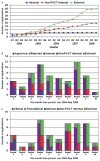Production Assistance for Cellular Therapies (PACT): four-year experience from the United States National Heart, Lung, and Blood Institute (NHLBI) contract research program in cell and tissue therapies
- PMID: 19170985
- PMCID: PMC4165072
- DOI: 10.1111/j.1537-2995.2008.02027.x
Production Assistance for Cellular Therapies (PACT): four-year experience from the United States National Heart, Lung, and Blood Institute (NHLBI) contract research program in cell and tissue therapies
Abstract
Background: In 2002, the US National Heart, Lung, and Blood Institute (NHLBI) conducted a workshop to determine needs of the cell therapy community. A consensus emerged that improved access to cGMP facilities, regulatory assistance, and training would foster the advancement of cellular therapy.
Study design and methods: A 2003 NHLBI request for proposals resulted in four contracts being awarded to three cell-manufacturing facilities (Baylor College of Medicine, University of Minnesota, and University of Pittsburgh) and one administrative center (The EMMES Corporation). As a result, Production Assistance for Cellular Therapies (PACT) was formed.
Results: As of October 1, 2008, PACT has received 65 preliminary applications of which 45 have been approved for product manufacture. A variety of cell therapies are represented including T-regulatory cells, natural killer cells, adipose-derived stem cells, cardiac progenitor cells for cardiac disease, hematopoietic progenitor cells (HPCs) for central nervous system applications, cytotoxic T lymphocytes, and dendritic cells. A total of 169 products have been administered under 12 applications and 2 reagents were manufactured and delivered. Fourteen peer-reviewed publications and 15 abstracts have resulted from the PACT project to date. A cell therapy textbook is nearly complete. PACT technical projects have addressed assay development, rapid endotoxin testing, shipping of cell products, and CD34+ HPC isolation from low-volume marrow. Educational Web seminars and on-site training through workshops have been conducted.
Conclusions: PACT is an active and successful cell therapy manufacturing resource in the United States, addressing research and training while forging relationships among academia, industry, and participating institutions.
Conflict of interest statement
All authors have signed a conflict of interest form and hereby attest that they have no conflict of interests to disclose regarding the publication of this article.
Figures



References
-
- Stroncek D, Harvath L, Barrett J. National Heart, Lung, and Blood Institute of the National Institutes of Health forum on immune reconstitution and cellular therapy following hematopoietic stem-cell transplantation. Cytotherapy. 2002;4:415–8. - PubMed
-
- Mondoro TH, Thomas JW, Henslee-Downey PJ, Peterson CM. NHLBI plans for the promise of cell-based therapies. Cytotherapy. 2005;7:317–27. - PubMed
-
- Leen AM, Sili U, Savoldo B, Jewell AM, Piedra PA, Brenner MK, Rooney CM. Fiber-modified adenoviruses generate subgroup cross-reactive, adenovirus-specific cytotoxic T lymphocytes for therapeutic applications. Blood. 2004;103:1011–9. - PubMed
-
- Sili U, Huls MH, Davis AR, Gottschalk S, Brenner MK, Heslop HE, Rooney CM. Large-scale expansion of dendritic cell-primed polyclonal human cytotoxic T-lymphocyte lines using lymphoblastoid cell lines for adoptive immunotherapy. J Immunother. 2003;26:241–56. - PubMed
Publication types
MeSH terms
Grants and funding
LinkOut - more resources
Full Text Sources
Medical
Research Materials
Miscellaneous

